Ten Great Campaigns
The Ten Great Campaigns (Chinese: 十全武功; pinyin: Shíquán Wǔgōng) were a series of military campaigns launched by the Qing Empire of China in the mid–late 18th century during the reign of the Qianlong Emperor (r. 1735–96). They included three to enlarge the area of Qing control in Inner Asia: two against the Dzungars (1755–57) and the "pacification" of Xinjiang (1758–59). The other seven campaigns were more in the nature of police actions on frontiers already established: two wars to suppress Jinchuan Tibetans in Sichuan, another to suppress the Taiwanese Aboriginals (1787–88), and four expeditions abroad against the Burmese (1765–69), the Vietnamese (1788–89), and the Gurkhas on the border between Tibet and Nepal (1790–92), with the last counting as two.
Campaigns
Three campaigns against the Dzungars and the pacification of Xinjiang (1755–59)
First campaign
| First Campaign against the Dzungars | |||||||||
|---|---|---|---|---|---|---|---|---|---|
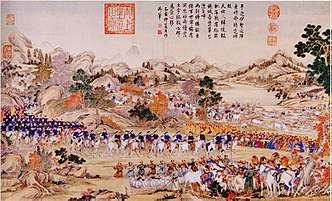 Surrender of Dawachi Khan in 1755 | |||||||||
| |||||||||
| Belligerents | |||||||||
| Qing dynasty | Dzungar Khanate | ||||||||
| Commanders and leaders | |||||||||
|
Qianlong Emperor Bandi (Overall Command) Zhaohui (Assistant Commander) Emin Khoja Amursana Burhān al-Dīn Khwāja-i Jahān | Dawachi (POW) | ||||||||
| Strength | |||||||||
|
9,000 Manchu Eight Bannermen 19,500 Inner Mongols 6,500 Outer Mongols 2,000 Zunghars 5,000 Uyghurs from Hami and Turfan 12,000 Chinese | 7,000 | ||||||||
| Casualties and losses | |||||||||
| Unknown | Unknown | ||||||||
Of the ten campaigns, the final destruction of the Dzungars (or Zunghars)[1] was the most significant. The 1755 Pacification of Dzungaria and the later suppression of the Revolt of the Altishahr Khojas secured the northern and western boundaries of Xinjiang, eliminated rivalry for control over the Dalai Lama in Tibet, and thereby eliminated any rival influence in Mongolia. It also led to the pacification of the Islamicised, Turkic-speaking southern half of Xinjiang immediately thereafter.[2]
Second campaign
In 1752, Dawachi and the Khoit-Oirat prince Amursana competed for the title of Khan of the Dzungars. Dawachi defeated Amursana various times and gave him no chance to recover. Amursana was thus forced to flee with his small army to the Qing imperial court. The Qianlong Emperor pledged to support Amursana since Amursana accepted Qing authority; among those who supported Amursana and the Chinese were the Khoja brothers Burhān al-Dīn and Khwāja-i Jahān. In 1755, Qianlong sent the Manchu general Zhaohui, who was aided by Amursana, Burhān al-Dīn and Khwāja-i Jahān, to lead a campaign against the Dzungars. After several skirmishes and small scale battles along the Ili River, the Qing army led by Zhaohui approached Ili (Gulja) and forced Dawachi to surrender. Qianlong appointed Amursana as the Khan of Khoit and one of four equal khans – much to the displeasure of Amursana, who wanted to be the Khan of the Dzungars.
| Second Campaign against the Dzungars | |||||||
|---|---|---|---|---|---|---|---|
 The Battle of Oroi-Jalatu in 1758, Zhao Hui ambushes Amursana at night. | |||||||
| |||||||
| Belligerents | |||||||
| Qing dynasty | Dzungars loyal to Amursana | ||||||
| Commanders and leaders | |||||||
|
Qianlong Emperor Bandi †(1757) (Overall Command until death in battle) Cäbdan-jab (Overall Command) Zhaohui (Assistant Commander) Ayushi Emin Khoja Burhān al-Dīn Khwāja-i Jahān |
Amursana Chingünjav † | ||||||
| Strength | |||||||
|
10,000 Bannermen 5,000 Uyghurs from Turfan and Hami Plus Zunghars | 20,000 Dzungars | ||||||
| Casualties and losses | |||||||
| Unknown | everyone defeated except for 50 men of Chingünjav who fled | ||||||
In the summer of 1756, Amursana started a Dzungar revolt against the Chinese with the help of Prince Chingünjav. The Qing Empire reacted at the start of 1757 and sent General Zhaohui with support from Burhān al-Dīn and Khwāja-i Jahān. Among several battles, the most important ones were illustrated in Qianlong's paintings. The Dzungar leader Ayushi defected to the Qing side and attacked the Dzungar camp at Gadan-Ola (Battle of Gadan-Ola).
Campaign in Altishahr (Third campaign)
General Zhaohui defeated the Dzungars in two battles: the Battle of Oroi-Jalatu (1758) and the Battle of Khurungui (1758). In the first battle, Zhaohui attacked Amursana's camp at night; Amursana was able to fight on until Zhaohui received enough reinforcements to drive him away. Between the time of Oroi-Jalatu and Khurungui, the Chinese under Prince Cabdan-jab defeated Amursana at the Battle of Khorgos (known in the Qianlong engravings as the "Victory of Khorgos"). At Mount Khurungui, Zhaohui defeated Amursana in a night attack on his camp after crossing a river and drove him back. To commemorate Zhaohui's two victories, Qianlong had the Puning Temple of Chengde constructed, home to the world's tallest wooden sculpture of the bodhisattva Avalokiteśvara and hence its alternate name, the 'Big Buddha Temple'. Afterwards, Huojisi of Turfan submitted to the Qing Empire. After all of these battles, Amursana fled to Russia (where he died) while Chingünjav fled north to Darkhad but was captured at Wang Tolgoi and executed in Beijing.
| Campaign in Altishahr (Pacification of Xinjiang) | |||||||
|---|---|---|---|---|---|---|---|
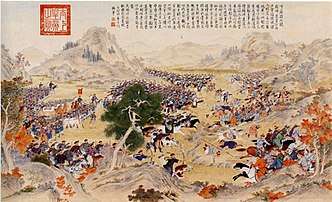 The Battle of Qurman 1759, Fude and Machang bring 600 troops to relieve Zhaohui in the Black River. | |||||||
| |||||||
| Belligerents | |||||||
| Qing dynasty |
Altishahri followers of the Khoja brothers Kyrgyzs Dzungar rebels | ||||||
| Commanders and leaders | |||||||
|
Qianlong Emperor Zhaohui (Overall Command) Fude (Assistant Commander) Agui Doubin Rongbao Zhanyinbao Fulu Shuhede Mingrui Arigun Machang Namjil † Yan Xiangshi Yisamu Duanjibu Khoja Emin Khoja Si Bek Sultan Shah of Badakhshan |
Khwāja-i Jahān POW Burhān al-Dīn POW | ||||||
| Strength | |||||||
|
10,000 Bannermen Uyghurs from Hami, Turfan and Badakshan Plus Zunghars | 30,000 Altishahr (Tarim Basin) Uyghurs | ||||||
| Casualties and losses | |||||||
| Unknown | Unknown | ||||||
After the second campaign against the Dzungars in 1758, two Altishahr nobles, the Khoja brothers Burhān al-Dīn and Khwāja-i Jahān, started a revolt against the Qing Empire. Apart from the remaining Dzungars, they were also joined by the Kyrgyz peoples and the Oases Turkic peoples (Uyghurs) in Altishahr (the Tarim Basin). After capturing several towns in Altishahr, there were still two rebel fortresses at Yarkand and Kashgar at the end of 1758. Uyghur Muslims from Turfan and Hami, including Emin Khoja and Khoja Si Bek, remained loyal to the Qing Empire and helped the Qing regime fight the Altishahri Uyghurs under Burhān al-Dīn and Khwāja-i Jahān. Zhaohui unsuccessfully besieged Yarkand and fought an indecisive battle outside the city; this engagement is historically known as the Battle of Tonguzluq. Zhaohui instead took other towns east of Yarkand but was forced to retreat; the Dzungar and Uyghur rebels laid siege to him at the Siege of Black River (Kara Usu). In 1759, Zhaohui asked for reinforcements and 600 troops were sent, under the overall command of generals Fude and Machang, with the 200 cavalry led by Namjil; other high-ranking officers included Arigun, Doubin, Duanjibu, Fulu, Yan Xiangshi, Janggimboo, Yisamu, Agui and Shuhede. On 3 February 1759, over 5,000 enemy cavalry led by Burhān al-Dīn ambushed the 600 relief troops at the Battle of Qurman. The Uyghur and Dzungar cavalry were stopped by the Qing zamburak artillery camels, musketry and archers; Namjil and Machang led a cavalry charge on one of the flanks. Namjil was killed while Machang was unseated from horseback and was forced to fight on foot with his bow. After a hard fought battle, the Qing forces emerged victorious and attacked the Dzungar camp, causing the Dzungars besieging the Black River to withdraw. After the victory at Qurman, the Qing army overran the remaining rebel towns. Mingrui led a detachment of cavalry and defeated Dzungar cavalry at the Battle of Qos-Qulaq. The Uyghurs retreated from Qos-Qulaq but were defeated by Zhaohui and Fude at the Battle of Arcul (Altishahr) on September 1, 1759. The rebels were defeated again at the Battle of Yesil Kol Nor. After these defeats, Burhān al-Dīn and Khwāja-i Jahān fled with their small army of supporters to Badakhshan. Sultan Shah of Badakhshan promised to protect them but he contacted the Qing Empire and promised to turn them over. When the fleeing rebels came to the Sultan's capital, he attacked them and captured them. When the Qing army reached Sultan Shah's capital, he handed over the captured rebels to them and submitted to the Qing Empire.
Suppression of the Jinchuan hill peoples (1747–49, 1771–76)
First campaign
| First Campaign against Jinchuan | |||||||
|---|---|---|---|---|---|---|---|
 Depiction of Qing troops on a campaign in Jinchuan ("Gold Stream") | |||||||
| |||||||
| Belligerents | |||||||
| Qing Empire | Jinchuan tribes | ||||||
| Commanders and leaders | |||||||
|
Qianlong Emperor Zhang Guangsi (Overall Command) (Executed by Qianlong) Naqin (Assistant Commander) (Executed by Qianlong) Fuheng (Overall Command) Zhaohui (Assistant Commander) |
Slob Dpon Tshe Dbang | ||||||
| Strength | |||||||
| Unknown | Unknown | ||||||
| Casualties and losses | |||||||
| Unknown | Unknown | ||||||
The suppression of the Jinchuan Tibetans was the costliest and most difficult, and also the most destructive of the Ten Great Campaigns. Jinchuan (lit. "Golden Stream") was located northwest of Chengdu in western Sichuan. The tribal peoples there were related to the Tibetans of Amdo. The first campaign in 1747–1749 was a simple affair; with little use of force the Qing army induced the native chieftains to accept a peace plan, and departed.
Second campaign
| Second Campaign against Jinchuan | |||||||
|---|---|---|---|---|---|---|---|
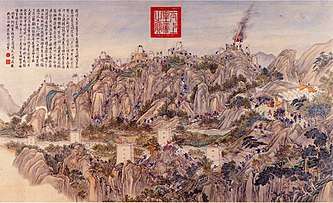 Qing general Fuk'anggan assaults Luobowa mountain tower | |||||||
| |||||||
| Belligerents | |||||||
| Qing Empire | Jinchuan tribes | ||||||
| Commanders and leaders | |||||||
|
Qianlong Emperor Agui (Overall Command) Fuk'anggan (Assistant Commander) Fude (Executed by Qianlong in 1776) Wenfu † |
Sonom Senggesang | ||||||
| Strength | |||||||
| 8,000 | Unknown | ||||||
| Casualties and losses | |||||||
| Unknown | Unknown | ||||||
Interethnic conflict brought Qing intervention back after 20 years. The result was the Qing forces being forced to fight a protracted war of attrition costing the Imperial Treasury several times the amounts expended on the earlier conquests of the Dzungars and Xinjiang. The resisting tribes retreated to their stone towers and forts in steep mountains and could only be dislodged by cannon fire. The Qing generals were ruthless in annihilating the local Tibetans, then reorganised the region in a military prefecture and repopulated it with more cooperative inhabitants.[2] When victorious troops returned to Beijing, a celebratory hymn was sung in their honour. A Manchu version of the hymn was recorded by the French Jesuit Jean Joseph Marie Amiot and sent to Paris.[3]
Campaigns in Burma (1765–69)
The Qianlong Emperor launched four invasions of Burma between 1765 and 1769. The war claimed the lives of over 70,000 Qing soldiers and four commanders,[4] and is sometimes described as "the most disastrous frontier war that the Qing dynasty had ever waged",[5] and one that "assured Burmese independence and probably the independence of other states in Southeast Asia".[6] The successful Burmese defence laid the foundation for the present-day boundary between Myanmar and China.[4]
First and second invasion
At first, Qianlong envisaged an easy war, and sent in only the Green Standard troops stationed in Yunnan. The Qing invasion came as the majority of Burmese forces were deployed in the Burmese invasion of the Siamese Ayutthaya Kingdom. Nonetheless, battle-hardened Burmese troops defeated the first two invasions of 1765 and 1766 at the border. The regional conflict now escalated to a major war that involved military maneuvers nationwide in both countries.
Third invasion
The third invasion (1767–1768) led by the elite Manchu Bannermen nearly succeeded, penetrating deep into central Burma within a few days' march from the capital, Ava.[7] However, the Bannermen of northern China could not cope with unfamiliar tropical terrains and lethal endemic diseases, and were driven back with heavy losses.[4] After the close-call, King Hsinbyushin redeployed most of the Burmese armies from Siam to the Chinese border.
Fourth invasion
The fourth and largest invasion got bogged down at the frontier. With the Qing forces completely encircled, a truce was reached between the field commanders of the two sides in December 1769.[5][8]
Aftermath
The Qing forces maintained a heavy military presence in the border areas of Yunnan for about a decade in an attempt to wage another war while imposing a ban on inter-border trade for two decades. The Burmese were also preoccupied with another impending invasion by the Qing Empire, and kept a series of garrisons along the border. After twenty years, Burma and the Qing Empire resumed a diplomatic relationship in 1790. To the Burmese, the resumption was on equal terms. However, the Qianlong Emperor unilaterally interpreted the act as Burmese submission, and claimed victory.[5] Ironically, the main beneficiaries of this war were the Siamese. After having lost their capital Ayutthaya to the Burmese in 1767, they regrouped in the absence of large Burmese armies, and reclaimed their territories over the next two years.[7]
Taiwan rebellion (1786–88)
In 1786, the Qing-appointed Governor of Taiwan, Sun Jingsui, discovered and suppressed the anti-Qing Tiandihui (Heaven and Earth Society). The Tiandihui members gathered Ming loyalists, and their leader Lin Shuangwen proclaimed himself king. Many important people took part in this revolt and the insurgents quickly rose to 50,000 people. In less than a year, the rebels occupied almost all of southern Taiwan. Hearing that the rebels had occupied most of Taiwan, Qing troops were sent to suppress them in a hurry. The east insurgents defeated the poorly organised troops and had to resist falling to the enemy. Finally, the Qing imperial court sent Fuk'anggan while Hailancha, Counsellor of the Police, deployed nearly 3,000 people to fight the insurgents. These new troops were well equipped, disciplined and had combat experience which proved enough to rout the insurgents. The Ming loyalists had lost the war and their leaders and remaining rebels hid among the locals.
Lin Shuangwen, Zhuang Datian and other Tiandihui leaders had started a rebellion which at first was successful, and as many as 300,000 took part in the rebellion. The Qing general Fuk'anggan was sent to quell the rebellion with a force of 20,000 soldiers, which he accomplished. The campaign was relatively expensive for the Qing government, although Lin Shuangwen and Zhuang Datian were both captured. After the revolt ended, the Qianlong Emperor was forced to rethink the method of government for Taiwan.
The Manchu Aisin Gioro Prince Abatai's daughter was married to the Han Chinese General Li Yongfang (李永芳).[9][10] Li's son was awarded the rank of "Third Class Viscount" (三等子爵; sān děng zǐjué) title.[11] Li Yongfang was the great great great grandfather of Li Shiyao (李侍堯) who during Qianlong's reign was involved in graft and embezzlement, stripped of his noble title and sentenced to death, however his life was spared and he regained his title after assisting in the Taiwan campaign.[12][13]
Two campaigns against the Gurkhas (1788–93)
The campaigns against the Gurkhas displayed the Qing imperial court's continuing sensitivity to conditions in Tibet.
First campaign
The late 1760s saw the creation of a strong state in Nepal and the involvement in the region of a new foreign power, the British Empire, through the British East India Company. The Gurkha rulers of Nepal decided to invade southern Tibet in 1788.
The two Manchu resident agents (ambans) in Lhasa made no attempt at defence or resistance. Instead, they took the child Panchen Lama to safety when the Nepalese troops came through and plundered the rich monastery at Shigatse on their way to Lhasa. Upon hearing of the first Nepalese incursions, the Qianlong Emperor ordered troops from Sichuan to proceed to Lhasa and restore order. By the time they reached southern Tibet, the Gurkhas had already withdrawn. This counted as the first of two wars with the Gurkhas.
Second campaign
In 1791, the Gurkhas returned in force. Qianlong urgently dispatched an army of 10,000. It was made up of around 6,000 Manchu and Mongol forces supplemented by tribal soldiers under the general Fuk'anggan, with Hailancha as his deputy. They entered Tibet from Xining in the north, shortening the march but making it in the dead of winter 1791–92, crossing high mountain passes in deep snow and cold. They reached central Tibet in the summer of 1792 and within two or three months could report that they had won a decisive series of encounters that pushed the Gurkha armies. The Nepalese outplayed with stretching tactics since the Chinese Army were 3-4 times larger. Nepalese began into pull back making Chinese uncomfortably outstretched and at Nuwakot, Chinese received strong counterattack with Khukuri. Since, Nepal was expanding in the West and Fuk'anggan was keen to protect his army, both signed Treaty at Betrawati.[14] Treaty was more favourable on Qing terms which forced them to pay tribute to the Qing Empire every five years.[2]
Campaign in Đại Việt (1788–89)
| Qing invasion of Vietnam | |||||||
|---|---|---|---|---|---|---|---|
 A depiction of the Battle at the Thọ Xương river, 1788. | |||||||
| |||||||
| Belligerents | |||||||
|
|
| ||||||
| Commanders and leaders | |||||||
|
|
| ||||||
| Strength | |||||||
|
20,000–200,000 Chinese troops[note 1] 20,000 Lê dynasty supporters | 100,000 (50,000 regulars, 20,000 newly recruited militia) | ||||||
| Casualties and losses | |||||||
|
20,000+ killed[16] 3,400 captured[17] | 8,000+ killed[18] | ||||||
Since the 17th century Vietnam was divided into two parts: the southern part was Đàng Trong or Cochinchina, ruled by the Nguyễn lords and the northern part was Đàng Ngoài or Tonkin, ruled by the Trịnh lords under the puppet Lê emperors. In 1771 the Tây Sơn rebellion broke out in southern Vietnam, led by the brothers Nguyễn Nhạc, Nguyễn Huệ and Nguyễn Lữ, who removed the local Nguyễn lord from power.
After the capture of Phú Xuân (modern Huế), Nguyễn Hữu Chỉnh, a traitor of Trịnh's general, encouraged Nguyễn Huệ to overthrow the Trịnh lord. Huệ took his advice, marched north and captured Thăng Long (modern Hanoi). In 1788, Lê Chiêu Thống was installed the new Lê emperor by Huệ. Huệ then retreated to Phú Xuân.
Meanwhile, Lê Chiêu Thống never abandoned his attempt to regain the throne. Lê Quýnh, Empress Dowager Mẫn and the eldest son of Lê Chiêu Thống, fled to Longzhou, Guangxi, to seek support from Qing China. A large Qing army invaded Vietnam to restore Lê Chiêu Thống to the throne. However, the Chinese army was defeated and after subsequent reconciliation, Qianlong recognized Nguyễn Huệ (aka Quang Trung) as the ruler of Vietnam.
What motivated the Qing imperial government to interfere in Vietnam's domestic affairs has always been disputed. Chinese scholars claimed that the Qianlong Emperor simply wanted to restore the Lê emperor and rule all Vietnam, seeking no territorial gains. Vietnamese scholars on the other hand have argued, that Qianlong intended to make Vietnam a vassal. China would station troops in Vietnam and install Lê Chiêu Thống as its puppet king.
Campaigns in perspective
In his later years, the Qianlong Emperor referred to himself with the grandiose style name of "Old Man of the Ten Completed [Great Campaigns]" (十全老人). He also wrote an essay enumerating the victories in 1792 entitled Record of Ten Completions (十全记).[19]
The campaigns were a major financial drain on the Qing Empire, costing more than 151 million silver taels.[20]
- The tribes at Jinchuan numbered less than 30,000 households and took five years to pacify.
- Nearly 1.5 million piculs (1 picul = 100 catties) of cargo were transported for the campaign in Taiwan.
- Instead of restoring Lê Chiêu Thống to the throne in Vietnam as the campaign had intended, the Qianlong Emperor ended up making peace with the new Tây Sơn dynasty and even arranged for marriages between the imperial families of Qing and Tayson.
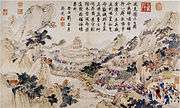 Fuk'anggan captures Camu from the Nepalese
Fuk'anggan captures Camu from the Nepalese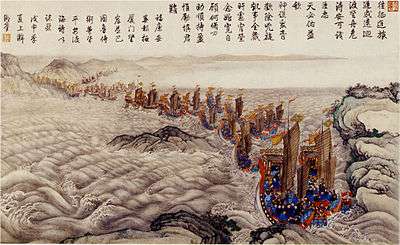 The Qing fleet returning from Taiwan
The Qing fleet returning from Taiwan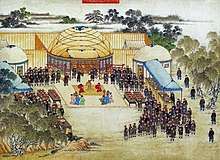 Chinese officials receiving the deposed Emperor Lê Chiêu Thống.
Chinese officials receiving the deposed Emperor Lê Chiêu Thống.
Notes
- The Chinese strength was disputed. Qing Shilu (Veritable Records of Qing) mentioned 20,000 Chinese troops.[15] Đại Nam thực lục (Veritable Records of Đại Nam) mentioned 200,000 Chinese troops.
References
- "Encyclopædia Britannica online entry on Kazakhstan, page 19 of 22". Britannica.com. 16 December 1991. Retrieved 19 February 2013.
- F.W. Mote, Imperial China 900–1800 (Cambridge, MA: Harvard University Press, 1999), 936–939
- "Manchu hymn chanted at the occasion of the victory over the Jinchuan Rebels". Manchu Studies Group. 18 December 2012. Retrieved 19 February 2013.
- Charles Patterson Giersch (2006). Asian borderlands: the transformation of Qing China's Yunnan frontier. Harvard University Press. pp. 101–110. ISBN 0674021711.
- Yingcong Dai (2004). "A Disguised Defeat: The Myanmar Campaign of the Qing Dynasty". Modern Asian Studies. Cambridge University Press. 38: 145. doi:10.1017/s0026749x04001040.
- Marvin C. Whiting (2002). Imperial Chinese Military History: 8000 BC – 1912 AD. iUniverse. pp. 480–481. ISBN 978-0-595-22134-9.
- DGE Hall (1960). Burma (3rd ed.). Hutchinson University Library. pp. 27–29. ISBN 978-1-4067-3503-1.
- GE Harvey (1925). History of Burma. London: Frank Cass & Co. Ltd. pp. 254–258.
- "李永芳将军的简介 李永芳的后代-历史趣闻网". www.lishiquwen.com. Retrieved 14 April 2018.
- "Archived copy". Archived from the original on 7 October 2016. Retrieved 30 June 2016.CS1 maint: archived copy as title (link)
- Evelyn S. Rawski (15 November 1998). The Last Emperors: A Social History of Qing Imperial Institutions. University of California Press. pp. 72–. ISBN 978-0-520-92679-0.
- http://www.dartmouth.edu/~qing/WEB/LI_SHIH-YAO.html
- http://12103081.wenhua.danyy.com/library1210shtml30810106630060.html
- "Tibetan and Nepalese Conflict". Official website of Nepal Army. Archived from the original on 7 June 2011.
- Guo & Zhang, p. 523-526
- Mùa Xuân Nói Chuyện Đống Đa-GS Trần Gia Phụng
- Đặng Phương Nghi 2006, Quang Trung-Nguyễn Huệ p. 298
- Đặng Phương Nghi 2006, Quang Trung-Nguyễn Huệ p. 292
- Monarchy in the Emperor's Eyes: Image and Reality in the Ch`ien-lung Reign. by Harold L. Kahn, The Journal of Asian Studies, Vol. 31, No. 2 (Feb., 1972), pp. 393–394
- Zhuang Jifa, Qing Gaozong Shiquan Wugong Yanjiu (Taipei, 1982), p.494. (庄吉发, 《清高宗十全武功研究》)